Hall
of history and grandeur
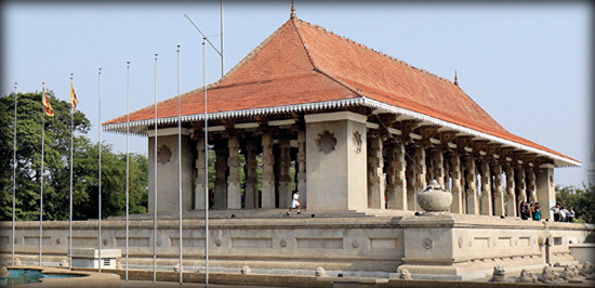 As Sri Lanka prepares to celebrate
its 68th Anniversary of Independence, we revisit the Independence
Memorial Hall where freedom is carved in four pithy words – ‘Ni’, ‘Da’,
‘Ha’ ‘Sa’ As Sri Lanka prepares to celebrate
its 68th Anniversary of Independence, we revisit the Independence
Memorial Hall where freedom is carved in four pithy words – ‘Ni’, ‘Da’,
‘Ha’ ‘Sa’
by Dilrukshi Handunnetti
As Sri Lanka prepares to mark the 68th Anniversary of Independence
from British yoke, the simple celebrations are also likely to mark the
final Independence celebration under the island’s second Republican
Constitution, introduced in 1978 by the J. R. Jayewardene
administration.
While the Galle Face Green prepares for this national event – marking
a new era under a constitution that is to be made this year –not too far
from the main venue lies a serene and aesthetic monument that proudly
marks Sri Lanka’s Independence from British rule on 4 February 1948.
In what was once known as Torrington Square and subsequently renamed
Independence Square, stands a flint-carved work of beauty that is among
the most remembered national monuments in the island– the Independence
Memorial Hall.
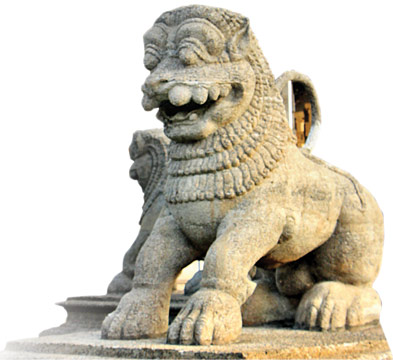 In
close proximity to this hall of history and grandeur is the statue of
Sri Lanka’s first post-Independence Prime Minister and the Father of the
Nation, Don Stephen Senanayake. In
close proximity to this hall of history and grandeur is the statue of
Sri Lanka’s first post-Independence Prime Minister and the Father of the
Nation, Don Stephen Senanayake.
Cultural heritage
The Memorial Hall bears testimony to Sri Lanka’s vast cultural
heritage and the architectural finesse that has survived many centuries,
combined into a single monument, reflects history and heritage of a
nation in granite elegance.
Overshadowed by the beautiful Independence Memorial Hall is the
basement museum, which provides invaluable information on the island’s
history, individual heroes and those who contributed to nurture the
island’s culture and arts, reflecting the evolution of a diverse nation.
Ceylon, as Sri Lanka was known then, drew strength from the
Independence struggle in India and directly benefitted from it. In 1948,
the island came to be known as the Dominion of Ceylon, ‘an equal nation
state that is not subordinate to another.’ Nearly a quarter century
later, Sri Lanka was renamed the Republic of Sri Lanka, on 22 May 1972,
subsequent to the promulgation of the island’s first Republican
Constitution.
The Independence Memorial Hall was constructed much later at the
location of the first Independence Day ceremony, in remembrance of the
opening of the country’s first Parliament. For many years, it had served
as the ceremonial assembly hall for the Senate of Ceylon and the House
of Representatives of Ceylon, until the House of Parliament was shifted
to Sri Jayewardenepura Kotte, the new political capital.
Work of art
The elegant structure was constructed to resemble the ‘Magul Maduwa’
of the Kandyan Kingdom – also known as the Royal Audience Hall or the
Celebration Hall. It was at the ‘Magul Maduwa’ that the Kandyan
Convention was entered into by the British rulers and the Kandyan
chieftains in March 1815, thus converting the island to a British
colony.
|
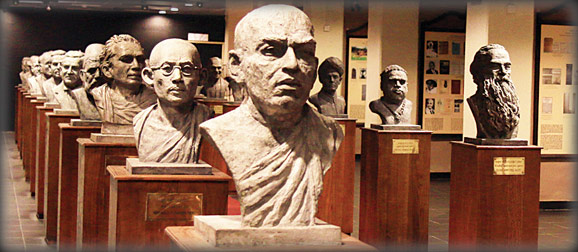
Bust images of various Sinhala heroes |
The original Audience Hall was created using solid wood but the main
structure was made out of concrete and reconstructed stone. The roof is
covered with traditional clay tiles, locally known as ‘Sinhala ulu’.
There are 60 pillars, similar to those found at the famous Embekke
temple in the Kandy District. The woodworks and carvings are typical
replicas of the famous Embekke art, with added features from the
island’s rich history such as the ‘Korawak Gala’ – a special type of
entrance stone – and ‘Punkalas’– a symbol of prosperity and sanctity.
Several steps lead to the main chamber where the inner walls reflect
the island’s history. Renovated in recent years, there are added
sculptures and artefacts, offering visitors an opportunity to learn
about the country’s legacy, of heroes from the past and facets of the
march for freedom.
At the main exhibition space, panels depict detailed descriptions
including the arrival of Prince Vijaya. There is a section dedicated to
the memory of King Pandukabhaya, referred to as the Golden Era of the
island, the various kingdoms that rose and fell and the many stages of
socio-cultural evolution of the island people.
There is also historical information about the arrival of the
Portuguese in 1505, the Dutch legacy and finally, the colonisation by
the British, signifying the end of native rule.
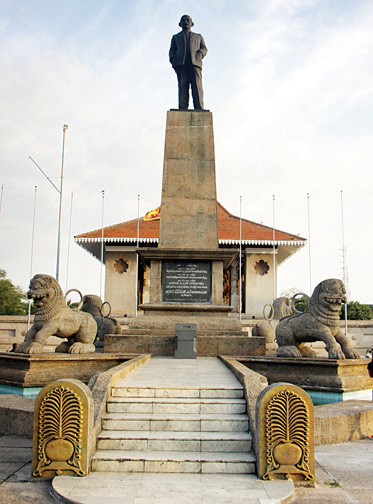 There
are bust images of various Sinhala heroes such as Keppitipola Nilame,
Pilimathalawe Nilame, Gongalegoda Banda and Veera Puran Appu. The museum
also records the proud legacy of several Buddhist monks who pioneered
Buddhist resurgence during periods of political suppression and
religious decline, such as Ven. Hikkaduwe Sri Sumangala Thera and Ven.
Migettuwatte Gunananda Thera, known for their indomitable spirit. There
are bust images of various Sinhala heroes such as Keppitipola Nilame,
Pilimathalawe Nilame, Gongalegoda Banda and Veera Puran Appu. The museum
also records the proud legacy of several Buddhist monks who pioneered
Buddhist resurgence during periods of political suppression and
religious decline, such as Ven. Hikkaduwe Sri Sumangala Thera and Ven.
Migettuwatte Gunananda Thera, known for their indomitable spirit.
|
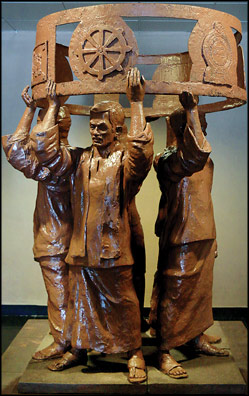
Symbolising unity |
Tribute is paid to the contributions made by lay persons in the
fostering of the Dhamma, including Henry Olcott and Srimath Anagarika
Dharmapala. Others who pioneered the revival of Hindu and Muslim
cultures too are celebrated here, including Sir Ponnambalam Arunachalam
and Mohammed Cassim Siddi Lebbe. Writers and scholars who contributed to
the culture and arts such as Martin Wickramasinghe, Ven. S. Mahinda
Thera, archaeologist Dr. Senerath Paranavitana, W. A. De Silva, John De
Silva and Prof. Gunapala Malalasekara too are remembered.
Recent history
The museum has a special section that records in detail, the
political changes that swept across the island closer to gaining
political independence in 1948. Murals and photographs of events and
people, invaluable images from the very first Independence Day
celebrations including the famous photograph of the then Premier, D.S.
Senanayake unfurling the island’s national flag are found here.
The ‘Table of Independence’ is certainly the jewel in the crown here.
It is a small polished-satinwood podium where the Declaration of
Independence of 1948 was signed. Four Sinhala letters are carved on the
table – ‘Ni’, ‘Da’, ‘Ha’ and ‘Sa’ – embellished with motif designs,
standing for the word – ‘nidahasa’ or freedom.
The renovated museum also pays tribute to the military personnel who
represented the three armed forces and those who died in the final war
in May 2009. A metal memorial sculpture contains their names, written on
an Ola leaf, reflecting an ancient tradition.
For the discerning eye – the elegant Independence Memorial Hall
presents a proud symbol of political independence from the British,
while the basement museum offers a slice of history – equally
significant. |

